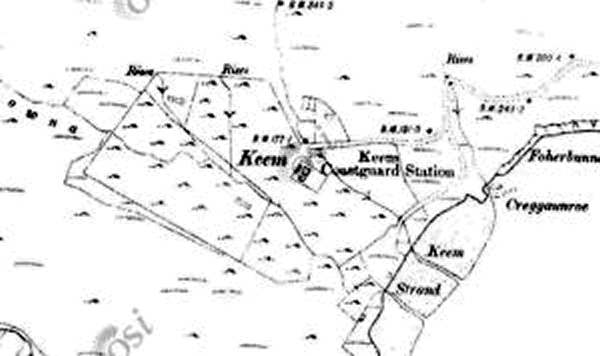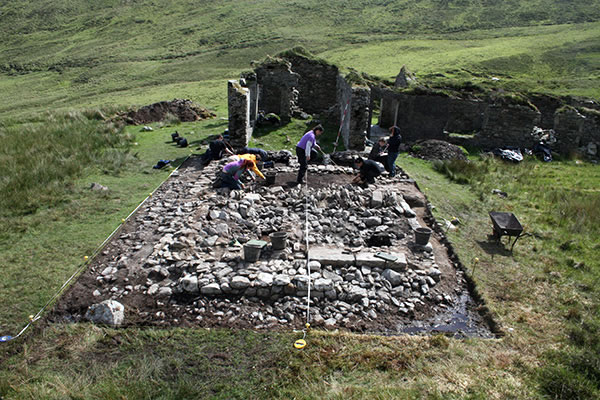Excavations at Captain Charles Boycott’s house in 2012
This article is © Copyright Achill Archaeological Field School

When ‘Captain’ Charles Cunningham Boycott arrived on Achill Island in 1854, he was just 22 years old, but he was already married and had left a short army career behind him to become a tenant farmer on a remote holding at the western tip of Ireland’s largest offshore island. Born into a clerical family in Burgh St Peter in Norfolk in 1832, Boycott joined the 39th Regiment of Foot in Preston in 1850 and held the rank of Ensign from then, through postings to Belfast, Newry, Dublin and Clonmel, until he resigned his commission in Clonmel in 1852 (Boycott 1997, 89-94). Military records indicate that he never achieved the rank of Captain during his time in the army, yet this rank is consistently applied to his name in contemporary accounts of his actions in the Ballinrobe area in 1880, when he became an infamous figure in the Irish Land War.
His arrival on Achill Island in 1854 was closely linked to the establishment of a Protestant mission on the island some twenty years earlier and Boycott leased 2,000 acres of land from Murray McGregor Blacker, this being a portion of the larger holding of 4,071 acres which McGregor Blacker had earlier leased from the Irish Church Mission Society (Boycott 1997, 150). McGregor Blacker’s holding encompassed the entirety of Keel West townland, the largest townland on Achill Island, and he appears to have taken over this holding after the death of his uncle, the noted agriculturalist William Blacker, who is listed as the holder of Keel West in Griffith’s Valuation.
The ruins of Boycott’s House, as it is still known today, overlook Keem Bay from a sheltered, levelled site with extensive sea and mountain views and while Keem is now easily accessible via a modern roadway, it was, in the nineteenth century, accessible only by sea or via a rough track over the high ground above the cliffs. The house stands as a roofless, single-storey stone-built house of L-shaped plan, though the short section of the ‘L’ was originally longer, since the walls of this part of the building terminate abruptly and were clearly built against a pre-existing element. In this way, it is clear that the missing component of the structure represents the earliest phase of construction and the building was subsequently extended in two further phases, the second phase involving the construction of the short section of the ‘L’ on the same alignment and the third phase comprising the longer part of the ‘L’ set at right angles to the two earlier phases. The site of the first-phase building was, at the commencement of the research project, a grass-covered mound which clearly contained a considerable amount of stone, but local folklore suggested that Boycott lived in an ‘iron house’ when he first came to Achill.

The excavation of the site of the Phase 1 structure exposed a low, rectangular wall which surrounded a hollow internal area and this feature, essentially a stone plinth, was 76 cm wide and appears to have acted as a foundation for a timber-framed structure which once rested upon it. The plinth measured 9.06 m long by 5.24 m across and was up to 47 cm high and the internal area was originally spanned by two large joists which were set into the longer walls of the plinth and which carried the timber floor of the building, though these were later replaced by a series of internal sub-walls. The superstructure of the building was clearly timber framed, as the remains of charred horizontal beams lie in situ on the plinth in places, and two sockets in the plinth, which still hold the remains of upright corner posts, were also noted. From this evidence, we can conclude that the plinth extended outwards from under the superstructure on at least three sides and the superstructure, which was therefore smaller than the plinth, appears to have measured 8.65 m long by 4.62 m wide. The building was clad externally with corrugated iron and some of this material, sealed in a thick deposit of heavy tar, remains in situ on the upper surface of the northern plinth. Further evidence for the use of corrugated iron in the structure may be found on the eastern ends of the walls of the Phase 2 structure, since the mortar on the ends of these walls retains the imprint of the corrugated iron and thus corroborates the suggestion that these walls were built against a pre-existing, iron-clad structure.

The excavation, undertaken by the Achill Archaeological Field School in 2012, produced clear evidence to support the local folk memory that Boycott’s House burnt down at some time in the 1860s and this event, a personal disaster for Boycott and his wife, ensured that a broad range of material culture would remain on the site, albeit much of it damaged by the fire. The excavation produced 1,034 sherds of pottery and 1,655 fragments of glass which included 114 fragments of glass vessels, 401 sherds of window glass and 1,140 other glass fragments of uncertain origin, most of which had been melted by the heat of the fire. The artefactual material also includes over 600 metal items, most of which are corroded iron nails, but this assemblage also includes a thimble, a safety pin and a series of buttons, one of which is decorated with a crown and the number ’39’, suggesting it is a regimental button from Boycott’s army tunic. Five pieces of amethyst found along the southern wall of the house suggest that a small collection of these stones had been gathered from the nearby amethyst quarry and placed together in a display near a window overlooking Keem Bay. While Charles and Annie Boycott had no children, five small porcelain limbs were found on the site and these, which appear to have belonged to children’s dolls, lend support to the published account of the fire which suggests that a couple from Sussex, with their young daughter, were visiting the house at the time (Boycott 1997, 162-3). The Boycott’s did not repair the house after the fire, but instead moved to Corrymore House overlooking Dooagh village for a few years (Boycott 1997, 163) and later left Achill and moved to Lough Mask House near Balinrobe in 1872.
A wider landscape study of the Keem Bay area is on-going, in an effort to identify the surviving evidence for the pre-Famine settlement nearby and the changes made to the landscape by Boycott in his efforts to bring modern agricultural practice to this remote and rugged area.
Bibliography
- Boycott, C.A. 1997. Boycott: The life behind the word. Carbonel, Ludlow.
- NaGhioban, M. 2001. Dugort, Achill Island 1831 – 1861: The rise and fall of a missionary community. Irish Academic Press, Dublin.
- Thomson, N. 2011. Corrugated Iron Buildings. Shire Publications, Oxford.
Read More:
- Sherlock, R. 2012. Prelude to Disaster: The Arrival of ‘Captain’ Charles Boycott on Achill Island in 1854 and the fire in the ‘Iron House’, Proceedings of the IAI Autumn 2012 Conference, Conference Proceedings 1, 2.
- Boycott’s House Excavations Bulletin 2012
- McDonald, T. 2016. A Guide to the Archaeological and Historical Sites on Achill, Achillbeg and the Corraun Peninsula. I.A.S. Publications.